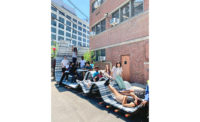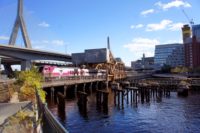ENR 2022 Top 25 Newsmakers
Sarah Cherry Rice: Changemaker Builds Design and Construction Program for Underrepresented Boston Youth

Rice founded and runs a pre-college STEM program in Boston to provide more Black and Latinx students access to related career paths, including in design and construction.
Photo by Jonathan Kozowyk
Related Article:
Considering Construction Careers, Underrepresented Boston Teens Build Inhabitable Sculpture
Back to:
25 Top Newsmakers
While working for former Boston Mayor Marty Walsh on a high school redesign project, Sarah Cherry Rice was part of a team that listened to approximately 2,000 people across the city, including students who wanted to graduate with real work experiences and no-cost college credits.
“Many students cited certain programs in middle school that had piqued their interest in architecture,” she says. “But they didn’t have connected experiences that allowed them to pursue this passion through high school into college and career.”
Realizing that an external organization could advance this cause, Rice—who holds a doctorate in education leadership from Harvard Graduate School of Education—created Digital Ready Boston.
The pre-college STEM nonprofit supported by contractors Gilbane and Suffolk, software vendor Autodesk and several local design firms builds these pathways to economic opportunities. Rice, Digital Ready’s executive director, says the program was among the first in the country to include a “Year 13,” or a bridge year that blurs “the lines between high school, higher education and industry."
Rice adds: "We had an explicit and intentional focus of making architecture and construction more accessible to groups that are vastly underrepresented, specifically Black and Latino students. Not only was it novel, but many students needed an additional year with connected resources and support to gain access to historically closed industry networks.”
COVID-19 forced Rice and her team to move classes online less than three months after launching the program. Her team drove across the city dropping off 3D printers for students and teaching others how to build 3D printers via webcam. “We were supporting social-emotional needs, housing; food insecurity; people were dying from COVID,” Rice recalls. “A lot of work involved talking about the vaccine … all that on top of starting a new program.”
Digital Ready eventually returned to in-person learning and found its stride. About 40 students from its first two cohorts are pursuing industry careers, including by enrolling in bachelor degree programs related to architecture or construction management, or by training to become carpenters.
Sandy Drew, 21, a first-year architecture student at Wentworth Institute of Technology, joined Digital Ready in 2020 as a shy high school junior looking to learn more about technology. “Sarah introduced me to the design tool Canva,” Drew says. She also met students from other schools, allowing her to grow out of her comfort zone.
Last summer, Digital Ready enrolled 22 students in its first five-week “learn and earn” Architecture and Construction design studio. While building a $75,000 inhabitable public sculpture temporarily installed in Boston’s Seaport, students earned three no-cost college credits and nearly $2,000 in wages, all while expanding their portfolios and learning technical skills such as sketching and 3D modeling.
Autodesk also trains students on its tools, including Tinkercad and Fusion 360, and offers paid work-based opportunities for students and alumni at its Boston office. “Sarah’s community-driven approach activates new and inspiring ways for industry and schools to work together to address opportunity gaps and to empower future innovators,” says Kellyanne Mahoney, the firm's youth program specialist.
Digital Ready also partners with the University of Massachusetts-Amherst Dept. of Architecture. Steve Schreiber, its chair of architecture, says Digital Ready “effectively immersed” students “in design fields. Sarah has brought a high amount of energy and excitement to this collaboration.”
For Rice there is one goal: “We are investing in future architects and engineers who will lead the city of Boston.”



